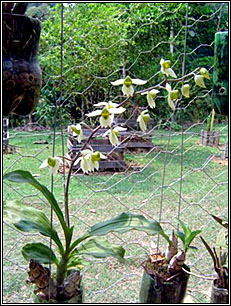 |
With
the experience, I found out that the best way to cultivate Catasetum
is to use a transparent container with water on the bottom. It
means, PET. And it also showed me that tree fern fiber is not
the best compost for Catasetum.
Coconut fiber is. It gives great results.
Soon, we got the ecological nursery: recycling domestic waste
of very very slow decomposition (PET) and using discards of coconut
fiber after drinking the water.
Perfect! |
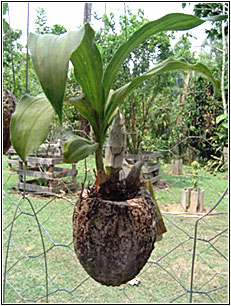 |
New
experiments and the orchid searches after its supply of calcium,
potassium and another nutrients directly on the bone! |
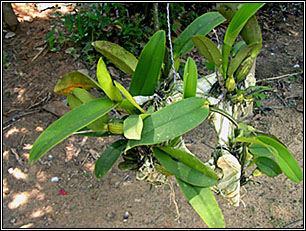
A clump of Cattleya labiata on a cow 'sambiquira' (bone cow) |
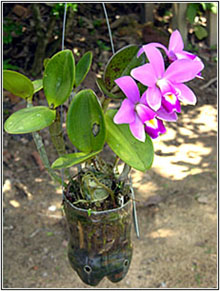 |
The
esthetic result was put on doubt and the bone (ox bone, of course!)
went inside the PET, disguised as compost. And the roots of Catasetum,
Cattleya violacea, even the micro-orchids, surround it
firmly. The flowers show more substance, last more. The leaves
are bigger, stronger. And the plants used to bloom twice a year! |
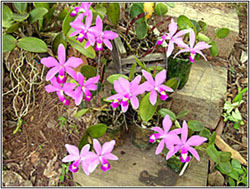 |
|
The
"ouriço" (chestnut bur) of castanha-do-Pará,
discarded by the collectors of the almonds became an attractive
container to orchids.
Perfect for cultivating micro-orchids and small "catasetinea".
As organic, besides to be a pot, it also acts as fertilizer. |
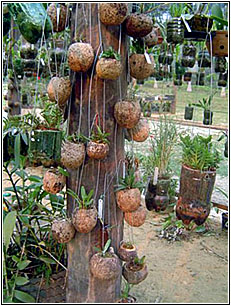 |
The
turtles of the lake need sand for reproducing and spawning so
an artificial small beach was created. The space soon became a
"violet nursery", taking advantage of the luminosity
and the humidity of the lake, shared with the alligators and turtles.
During the dry months, from May to September, the 'Capuchin monkey'
(Cebus apella) a noisy and curious flock attend regularly
and explore every corner of the property. Catasetum pseudobulbs
are succulent! They become basic item of the menu. The clamp of
Rodriguezia lanceolata on the guava tree was literally
cooked by the urine of those primates. Nowadays, five flocks of
different species take turns to visit the property, looking for
a safe place to playing and have food. They are: Sagüi (Callithrix),
quatar,zogue-zogue (Callicebus), Capuchin monkey
and Red Howler (Alouatta seniculus).
The result of the space reserved for the Cattleya violacea
showed us the way!
The orchids love the "trio" luminosity/humidity/ventilation,
the lake should be better explored.
Recreation boats which anchored around the river islands of the
region, called floating, showed the inspiration.
In May, we built the first nursery over the water as far as we
know: A floating nursery.
|
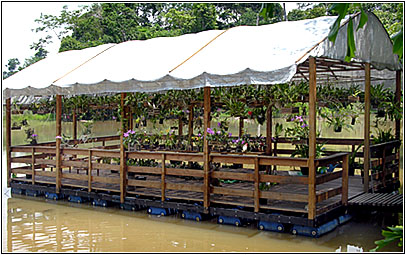
A
floating nursery, cultivate orchids is a trip! |
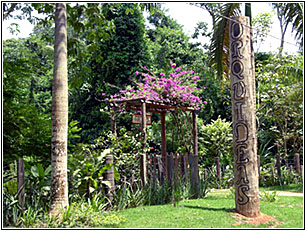 Entrance
- outside view
Entrance
- outside view
|
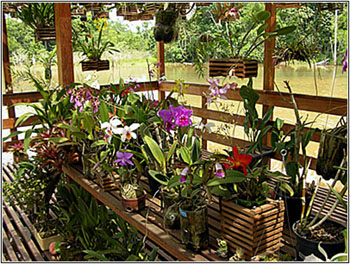
In the staging in the middle of the floating nursery, the orchids
in flowers. |
|
However
before that, the property became place searched for visitation,
photos, strolls, school picnics...
Since 2002, we developed a regular program of environment education.
Schools bring their pupils in small groups of, more or less, twenty.
They stroll, observe free animals living together with us, admire
wonderful orchids in flower, get knowledge about ecology, environmental
preservation and finish with a snack.
Orchids are our passion (the whole united family). We can't get
away from the affective value we aggregate that is why is not
our target to sell them.
|
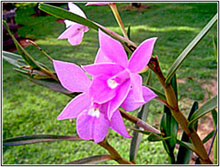
Dimerandra emarginata |
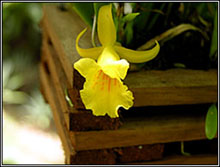
Plectrophora iridifolia |
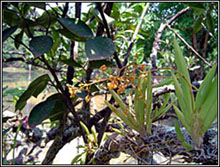
Trizeuxis falcata |
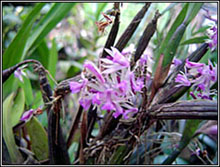
Scaphiglottys violacea (Scgl graminfolia) |
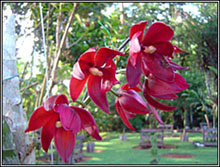
Cycnodes Wine
Delight 'Jem' FCC/AOS |
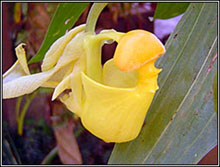
Coryanthes vieirae |
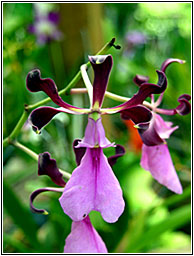
Encyclia cordigera |
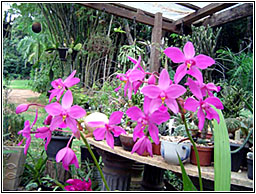
Spathoglottis plicatta |
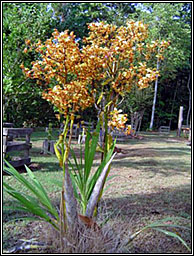
Cyrtopodium saint-legerianum |
Nowadays
we are inscribed in the program of tourism and city-tour of the
local government, with remunerated strolls which is not only for
admiring orchids but also a very big collection of Cactaceae,
Heliconiaceae, Araceae and animals. |
|
Animals became another legend: our "endowment" for living
with snakes. We two snake-pets, in fact two mascots which walking
around the nursery looking for tree-fogs for satiating hunger.
There is also the story of a huge python (three meters!), which
freedom has been ransomed for R$ 10,00 (at about US$ 4,00). |
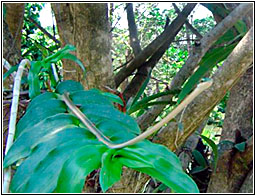 |
There
is also 'leca', an albino fog-tree which constrained us to dislodge
an orchid, just letting a drainage on the bottom of the container
with a supply of water to keep it fresh. It is living there for
months... beautiful, isn't it? |
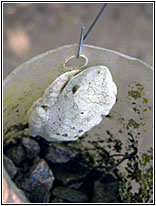 |
|
And
thus, Recanto das Orquídeas property (Orchids Corner),
in Alta Floresta-Mato Grosso, 800km far from Cuiabá, is
an ecological sanctuary. Since 17:00hs, we can have, sitting down
on the floating nursery, inhaling magnificent perfumes of orchids
and seeing it fantastic colors, an incredible vision of thousands
of 'garças' (Ardea bird) coming for overnight staying.
The tree chosen becomes white pure, the uproar starts lightly
with the firsts birds and increases when numerous flocks lodge
themselves, and decreases as the night falls. And if you look
the same trees at dawn, by 5 o'clock, you will think everything
was a dream: quietly, the birds went away with the first twinkling
of day, looking for their food adventures of insects to taste.
But this show has a term: the flood is starting, the Pantanal
calls them for the reproducing period which is beginning. In November,
just a few will be here. In December, only the photos will recall
the souvenirs ... however in July, they will be back. |
|
| Garças
(Ardea) - a show to vie with the orchids. In a little more than
30 minutes (from 6 pm to three past 6) the tree changes it color. |
|
|
Precious
tips to cultivate Catasetum by Apolonia Grade
Compost: if possible, use coconut fiber, however the tanine
should be removed before. You should be soaked in water and change
the water for many days, until the water is not red any more.
Tree fern fiber does not allow the best development for the plant.
Container: use PET or transparent jars bought at packaging
stores. Remember let a place to water at the bottom of the container,
at least, 5 cm depth.
Drainage: The best if clay roof tiles shivers. Rock crusher
varies in composition, sometimes acid, sometime more alkaline,
it changes the final pH.
Fertilizer: As soon as the roots start in the new pseudobulbs,
apply a support fertilization. I use 'osmocote' 14-14-14, of slowly
liberation, a tea spoon for each PET. It can also be organic such
as bocashi. This procedure is fundamental to guarantee the vigor
of the pseudobulb in formation and giving the plant the conditions
to have a blooming in its maximum potential.
Watering: Never sprinkle water on the sprout or on the
young leaves. It is the weakness of catasetum, the great "causa
mortis" of this genus. Water well the compost and keep the
water on the bottom of the container while the sprout grows.
Luminosity: Full sun, you will have incidence of female
bloom. 50% shade guarantee many inflorescence carrying male flowers
- which the desirable by the shape and the colors, with some female
flowers or even hermaphrodite. 70% shade, you will only have male
flowers.
The best place to place your catasetum:
High in the nursery!!! Hanged !
Never let your catasetum on the staging, put it hanged. The ideal
is let 1,5 m gap between the plant and the roof, supplying a good
ventilation.
During the dormancy period, after leaves drop, let the plant in
a dry and well ventilated place. Do not soak, just slightly moisten
the compost weekly. Never fertilize a plant during the period
neither repot it. Wait for the sprout and the firsts roots, then
water abundantly, fertilize, or repot, or divide... it means,
the cultural cares.
That
is the way I do!
Apolônia
Photos: René Rocha
Any
kind of reproduction (print, digital or anyone) of any type
of material of this site: texts, layout, photos, images
and others - is
strictly forbidden without previous written permission of
the authors. Any solicitation or information by the e-mail:
bo@sergioaraujo.com |
|
|